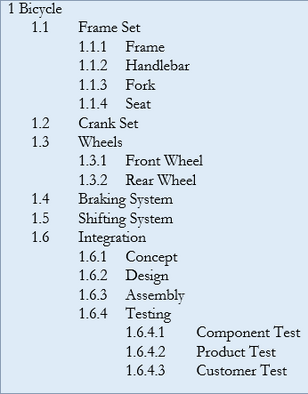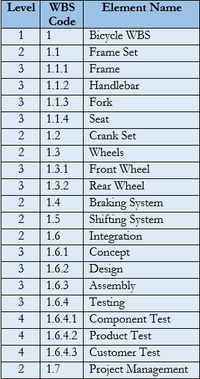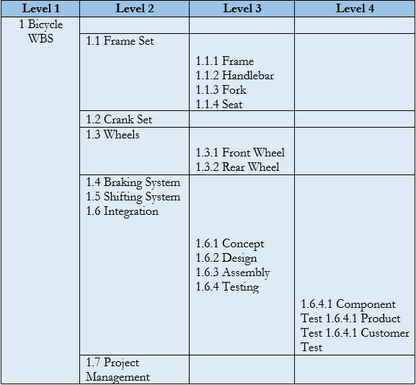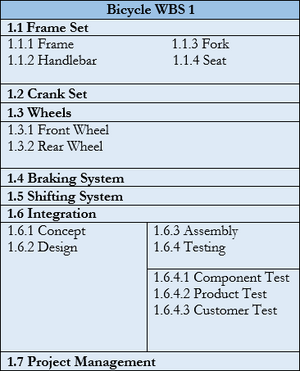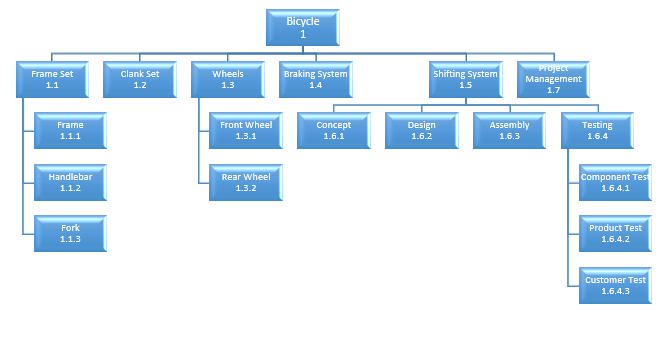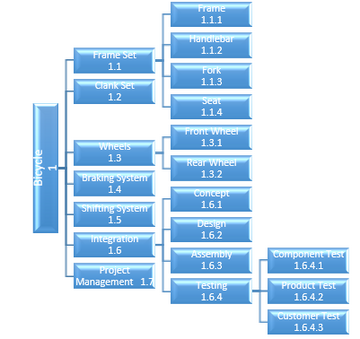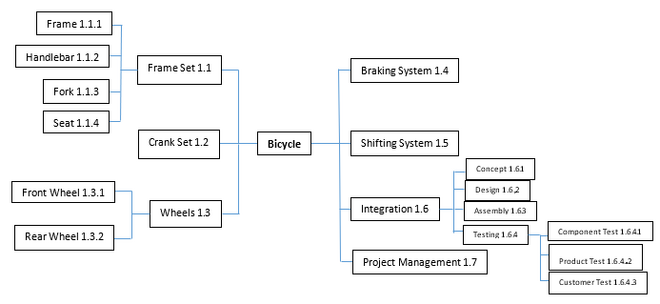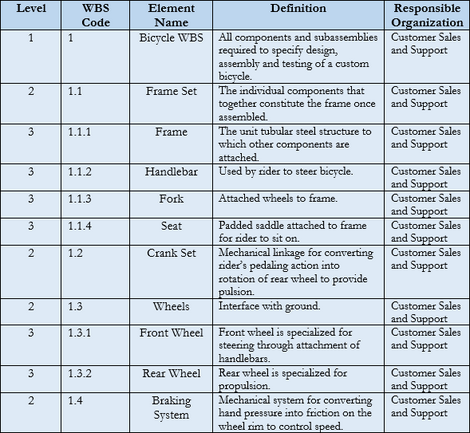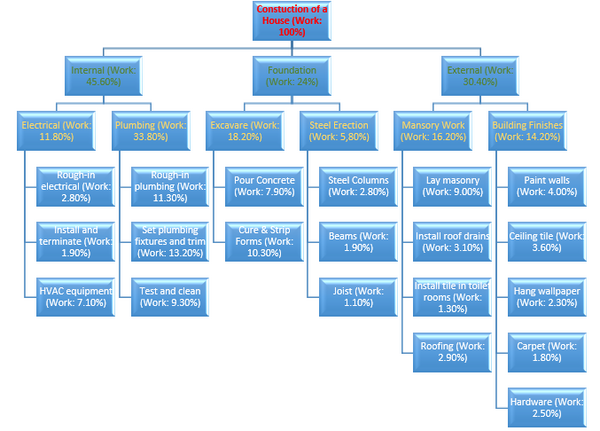Work Breakdown Structure
(→Representation of the Work Breakdown Structure) |
|||
| (104 intermediate revisions by 2 users not shown) | |||
| Line 1: | Line 1: | ||
| − | + | ''Developed by Ioannis Papadantonakis'' | |
| − | |||
| − | == | + | It is beyond any reasonable doubt that the ''Work Breakdown Structure (WBS)'' is an exceptionally useful tool for planning, estimating, scheduling and controlling any kind of project. The term WBS describes the procedure of subdivision of the project deliverables and workload into smaller more manageable segments. More specifically, “The WBS is a hierarchical decomposition of the total scope of work to be carried out by the project team to accomplish the project objectives and create the required deliverables.” (PMBOK® Guide-Fifth Edition, 2013, p. 126)<ref name="one">Project Management Institute. “A Guide to the Project Management Body of Knowledge (PMBOK® Guide)”- Fifth Edition, 2013, p.126</ref> |
| + | |||
| + | The purpose of this wiki-article is not only to thoroughly describe the capabilities and restrains of this method but also to provide guidance to ''project managers'' concerning the techniques that can be used for the effective implementation of project Work Breakdown Structures. | ||
| + | |||
| + | |||
| + | ==Big Idea== | ||
===Historical Retrospection=== | ===Historical Retrospection=== | ||
| − | The | + | |
| + | The initial forms οf the Work Breakdown Structure (WBS) were developed by the U.S. Department of Defence (DoD) and the National Aeronautics and Space Administration (NASA) at the mid-1960s with a view to regulating projects which had the ultimate goal of enhancing military and space systems respectively. Moreover, the management of these projects was undertaken by a central administration office and many different industrial contractors were recruited in order to contribute to the accomplishment of the huge variety of tasks. So, the WBS tool was used to “…ensure that the total project is fully planned and that all derivative plans contribute directly to the desired objectives” (NASA, 1962). After two decades; namely in 1987 the Project Management Institute introduced the Project Management Book of Knowledge (PMBOK) which provided the necessary guidance on how work breakdown structures could be applied in any kind of project.<ref>Eric S. Norman, Shelly A. Brotherton, Robert T. Fried. “Work Breakdown Structures: The Foundation for Project Management Excellence”- John Wiley & Sons, 2008, p. 4-5</ref> | ||
===Work Breakdown Structure Definition=== | ===Work Breakdown Structure Definition=== | ||
| − | + | The WBS process is characterized by the disintegration of the project into separate segments with the aim of managing it in a more efficient and effective way. Furthermore, this practical tool facilitates many other project management procedures like scheduling, efficient resource allocation, monitoring and control of the project. Also, the Work Breakdown Structure provides a complete and clear view of the project scope and deliverables.<ref>Project Management Institute. “Practice Standard for Work Breakdown Structures”- Second Edition, 2011, p. 3</ref> In addition, it presents with clarity the total workload as determined by the scope statement of the project and analyzes the planned work at the lower levels, also known as work packages. With the help of work packages, the activities that contribute to the planning, assessment, supervision, and control of operations are grouped together.<ref name="one" /> | |
| − | + | ||
| − | + | ===Work Breakdown Structure Framework=== | |
| − | + | The Work Breakdown Structure (WBS) consists of several layers which are grouped at the upper and lower levels. Below the composition of a typical WBS is described. | |
| − | + | ||
| − | + | ||
| − | + | ||
| − | + | ||
| − | + | ||
| − | + | ||
| − | + | ||
| − | + | To begin with, the content of the upper WBS levels may vary depending on the type of project and the industry involved. More generally, the main areas of the project are included at these levels. Then we have the lower WBS elements which mainly focus on supporting specific project management processes such as schedule development, cost estimation, resource allocation and risk assessment. These levels are called ''Work Packages''. The official definition of the Work Package is: “A deliverable or project work component at the lowest level of each branch of the work breakdown structure. The work package includes the schedule activities and schedule milestones required to complete the work package deliverable or the project work component.” (PMBOK® Guide-Third Edition, 2004, p.380). Finalizing WBS is done by assigning each work package to a ''control account'' and creating a separate identifier for that work package. With the help of these identifiers, the hierarchical summation of the cost, schedule and resources is achieved. “A control account is a management control point where scope, budget, actual cost, and schedule are integrated and compared to the earned value for performance measurement.” (PMBOK® Guide-Fifth Edition, 2013, p.132). Each control account typically involves one or more work packages while each work package cannot be linked to more than one control account. Additionally, these management control points are associated with more than one planning package, which is part of the WBS under the control account with given work content but without specified detailed activities.<ref>Project Management Institute. “A Guide to the Project Management Body of Knowledge (PMBOK® Guide)”- Fifth Edition, 2013, p.132</ref> | |
| − | A | + | ===Work Breakdown Structure Key Features=== |
| + | |||
| + | Some of the most important prerequisites for qualifying a WBS as qualitative and successful are listed below: | ||
| + | *A key feature of WBS is that it is deliverable oriented. In particular, a ''deliverable'' is defined as “Any unique and verifiable product, result or ability to perform a service that must be produced to complete a process, phase or project” (PMBOK® Guide-Third Edition, 2004, p.358). Therefore, the WBS should be aligned with the individual deliverables. | ||
| + | *A functional WBS is a hierarchical decomposition of the work. ''Decomposition'' is “a planning technique that subdivides the project scope and project deliverables into smaller more manageable components until the project work associated with accomplishing the project scope and providing the deliverables is defined in sufficient detail to support executing, monitoring, and controlling the work.” (PMBOK® Guide-Third Edition, 2004, p.358). In this way, a clear definition of the project scope is achieved with the use of independent sub-deliverables.<ref>Eric S. Norman, Shelly A. Brotherton, Robert T. Fried. “Work Breakdown Structures: The Foundation for Project Management Excellence”- John Wiley & Sons, 2008, p. 13</ref> | ||
| + | *An effective WBS manages to share the project scope with all the stakeholders. | ||
| + | *The work packages it contains should clearly identify the tasks that need to be performed with a view to delivering the work package deliverables. | ||
| + | *Another important prerequisite is the participation of experienced subject experts (SMEs) as well as skillful financial and business managers in its construction. | ||
| + | *It should follow a common course with the development of the project scope until the final definition of the scope. | ||
| + | *The WBS must be open to continuous improvements that may be needed after setting the project scope.<ref>Project Management Institute. “Practice Standard for Work Breakdown Structures”- Second Edition, 2011, p. 20</ref> | ||
| + | |||
| + | ===Representation of the Work Breakdown Structure=== | ||
| + | |||
| + | A WBS can be represented in a variety of ways in order to achieve its goal. Also, a particular WBS can have different forms in a given project. Below, a presentation of all the possible WBS forms and the implementation of them in a ''bicycle construction'' project is taking place. | ||
| + | *Outline View | ||
| + | One of the most common representations of the WBS is the ''Outline View''. In particular, there are numbered recesses for each level. The main tools used to construct outline views are word processors and spreadsheets. '''Figure 1''' depicts this form of representation. | ||
| + | Another version of the outline view is the use of simple numbering for different levels with a view to presenting the hierarchical structure of the WBS. '''Figure 2''' delineates this kind of Overline View. | ||
| + | The first form is a more descriptive representation of the WBS while space saving is achieved with the help of the latter. | ||
| + | <div><ul> | ||
| + | <li style="display: inline-block;"> [[File:Outline_View.png|thumb|none|308px|Figure 1: Outline View including recesses, inspired by the “Practice Standard for Work Breakdown Structures”-Second Edition (2011)]] </li> | ||
| + | <li style="display: inline-block;"> [[File:Outline_View_2.png|thumb|none|200px|Figure 2: Hierarchical Outline View, inspired by the “Practice Standard for Work Breakdown Structures”-Second Edition (2011)]] </li> | ||
| + | </ul></div> | ||
| + | *Tabular View | ||
| + | An equally common method of representing a WBS is the ''Tabular View''. The presentation of levels and hierarchy is done by using table columns. This representation is mainly used due to the absence of design tools.This kind of representation is described at '''Figure 3'''. | ||
| + | Another form of this kind of representation includes some additional cost and organizational information regarding each level. Usually, this type is found in governmental publications. Α con of this version is that it can display only a limited number of levels.'''Figure 4''' displays this Tabular View form. | ||
| + | <div><ul> | ||
| + | <li style="display: inline-block;"> [[File:Tabular_View_1.png|thumb|none|416px|Figure 3: Tabular View, inspired by the “Practice Standard for Work Breakdown Structures”-Second Edition (2011)]] </li> | ||
| + | <li style="display: inline-block;"> [[File:Tabular_View_2.png|thumb|none|300px|Figure 4: Tabular View, inspired by the “Practice Standard for Work Breakdown Structures”-Second Edition (2011)]] </li> | ||
| + | </ul></div> | ||
| + | *Tree Structure View | ||
| + | The ''Tree Structure'' or "Organizational Chart" is probably the most common way of representing the WBS. More specifically, the main feature of this structure is that the "child" elements are presented as boxes that are linked through lines with the "parent" elements of which they are components. With the help of this representation, the process of decomposing the project into increasingly smaller elements is prominently displayed. Usually, the overall project is placed at the top of the tree structure and below the various levels of decomposition continue as depicted at '''FIgure 5'''. | ||
| + | Another form of tree structure presentation involves placing the project on the left and decomposing the work to the right. An example of this kind of presentation is the ''horizontal orientation'' which is shown at '''Figure 6'''. | ||
| + | Another method of this representation is the ''Centralized Tree Structure'' where the project is at the centre of the layout and the decomposition of the levels is directed to the right and left. A prerequisite for developing this form is the use of appropriate software that takes into account the group interaction. This tree structure genre is described at '''Figure 7'''. | ||
| + | <div><ul> | ||
| + | <li style="display: inline-block;"> [[File:Tree_Structure_1.png|thumb|none|780px|Figure 5: Vertical Tree Structure View, inspired by the “Practice Standard for Work Breakdown Structures”-Second Edition (2011)]] </li> | ||
| + | <li style="display: inline-block;"> [[File:Tree_Structure_View_2.png|thumb|none|360px|Figure 6: Horizontal Tree Structure View, inspired by the “Practice Standard for Work Breakdown Structures”-Second Edition (2011)]] </li> | ||
| + | <li style="display: inline-block;"> [[File:Tree_Structure_3.png|thumb|none|660px|Figure 7: Centralized Tree Structure View, inspired by the “Practice Standard for Work Breakdown Structures”-Second Edition (2011)]] </li> | ||
| + | </ul></div> | ||
| + | *Enhanced Uses | ||
| + | The main feature of this representation is the provision of further information on the individual elements. The ''WBS dictionary'' is an example of an enhanced use of the WBS. More specifically, the WBS dictionary provides detailed definitions for all WBS items as well as information regarding the resources associated with the various tasks. A WBS Dictionary regarding the ''Bicycle Project'' is depicted at '''Figure 8'''.<ref> Project Management Institute. “Practice Standard for Work Breakdown Structures”- Second Edition, 2011, p. 52-63 </ref> | ||
| + | <div><ul> | ||
| + | <li style="display: inline-block;"> [[File:WBS_Dictionary.png|490px|thumb|none|470px|Figure 8: WBS Dictionary, inspired by the “Practice Standard for Work Breakdown Structures”-Second Edition (2011)]] </li> | ||
| + | </ul></div> | ||
| + | |||
| + | ==Application== | ||
===Creating WBS: Tools and Techniques=== | ===Creating WBS: Tools and Techniques=== | ||
| − | ==== | + | ====WBS Methods==== |
| − | + | The creation of a WBS can be carried out with the help of a wide variety of methods. Some of the most common and important ones are presented and analyzed below. | |
| − | + | =====Decomposition===== | |
| − | + | ||
| − | + | ||
| − | + | ||
| − | + | ||
| − | = | + | With the help of the ''decomposition'' technique, the scope of the project and the project deliverables are subdivided into work packages. The greater the difficulty of effectively controlling the project is, the higher the level of decomposition becomes. Also, depending on the size and complexity of the project, the level of detail for the work packages is determined. The process of decaying the entire project into work packages includes the following activities: |
| + | *Determine and analyze both project deliverables and work related to them. | ||
| + | *Construction and analysis of WBS. | ||
| + | *Disintegration of the higher levels of WBS to more detailed lower-levels. | ||
| + | *Create and match the identification codes to the corresponding components of the WBS. | ||
| + | *Evaluation of the decomposition rate of the deliverables.<ref name="two">Project Management Institute. “A Guide to the Project Management Body of Knowledge (PMBOK® Guide)”- Fifth Edition, 2013, p.128</ref> | ||
| − | Expert | + | =====Expert Judgment===== |
| − | + | ''Expert judgement'' is a very useful method which contributes to the procedure of analyzing the data needed to break down the project deliverables into more manageable pieces with a view to building an effective WBS. Specifically, this method addresses the technical characteristics of the scope of the project and aims to find the ideal way to dissolve the overall scope. The truth is that any group with relevant expertise and experience with a corresponding project is able to provide expert judgment. In addition, the expert judgment is available in the form of pre-defined standards, which are usually of an industrial nature and products of previous project experience. The project manager uses this practical and indispensable method in order to achieve the final breakdown of the project scope into the individual work packages, which in turn will contribute to the effective management of the project’s work.<ref name="two" /> | |
| − | + | =====Top-Down Method===== | |
| − | + | The following steps describe the general ''top-down'' process for developing a WBS: | |
| − | + | #Determination of the final products of the project. At this stage, the products that make the project successful are defined. A basic prerequisite for achieving the alignment between WBS and project requirements is the detailed overview of high-level project scope documents, examples of which are the ''Statement of Work'' and the ''Technical Requirements''. | |
| − | + | #Determination of the project's main deliverables, which are of key importance for the development of the project but are not capable of satisfying the business needs by themselves. | |
| − | + | #Decompose the main deliverables to the point of being easier to manage and control. The set of these independent WBS elements at each level should represent 100% of the work in the upper element. Also, each work package should not include more than one deliverable. | |
| + | #Continuous improvement of WBS in order to satisfy stakeholders. In particular, the development of the WBS should be continued until there is a common understanding that the project will be successful and the implementation and control process will produce the desired result.<ref name="three">Project Management Institute. “Practice Standard for Work Breakdown Structures”- Second Edition, 2011, p. 29-30</ref> | ||
| + | =====Bottom-Up Method===== | ||
| + | |||
| + | The ''Bottom-Up'' process includes the following 6 steps: | ||
| + | #Identify all deliverables related to the project. If activities are proposed then their deliverables should be included but not the activities themselves. In this way, the whole effort will be presented. In addition, each work package must not include more than one deliverable. | ||
| + | #Grouping of associated work packages. | ||
| + | #Concentrate the deliverables to the next level (e.g. the parent level) in such a way that the sum of the elements of each level represents 100% of the work below it. | ||
| + | #After a group of related tasks has been assigned to a parent, a subgroup analysis should be performed to ensure that work has not been neglected. | ||
| + | #The process continues until all of the individual elements join a particular “parent” representing the project. Also, the complete response to the overall project scope should be checked. | ||
| + | #Continuous improvement and revision of the WBS until the project stakeholders recognize the project's feasibility and the fact that its implementation will lead to the desired results.<ref name="three" /> | ||
| + | |||
| + | =====WBS (Organizational) Standards===== | ||
| + | |||
| + | An ''organizational WBS'' standard includes a set of principles that contribute to the creation of a WBS and is likely to include a form, enumeration plan, name agreement or necessary components. Most organizations with experience in project management have WBS standards. These standards ensure the creation of effective and integrated WBS for the company. Moreover, the use of these standards helps the promotion of consistency as WBS components are reused.<ref name="three" /> | ||
| + | |||
| + | =====WBS Templates===== | ||
| + | |||
| + | A ''WBS template'' is either a WBS sample that includes hierarchy to some extent or a general WBS "container" which is modified according to the needs and requirements of each project. Organizations usually have different types of templates that respond to different types of projects and life cycles. With the help of WBS templates, consistency is achieved as in the case of WBS standards. However, special attention is needed when reusing existing components as any non-required deliverables should be removed in order to align the WBS with the project scope.<ref name="three" /> | ||
| + | |||
| + | '''In conclusion''', the main difference between WBS standards and WBS templates in relation to Top-Down and Bottom-Up methods is that the former are based on the reuse of WBS components while the latter are methods of creating new WBSs. | ||
| + | |||
| + | ====WBS Tools==== | ||
| + | |||
| + | The tools that are available to the project manager in order to build and manage a WBS are abundant. Next, the features of the main tools, as well as the advantages and the drawbacks that accompany them are presented. | ||
| + | |||
| + | =====Coloured Sticky Notes===== | ||
| + | |||
| + | The first types of tools included the use of paper and pencil. A few years later the ''Coloured Sticky Notes'' appeared. Although this tool is not so technologically advanced, it is widely used today to organize and structure any WBS. This tool works as follows: the notes represent the project deliverables and are grouped on a whiteboard with the aim of successfully presenting the WBS hierarchical structure. | ||
| + | |||
| + | =====Project Management Scheduler===== | ||
| + | |||
| + | The most important feature of ''Project Management Scheduling'' tools is the fact that they integrate the WBS with the project schedule, which is very useful for the effective design of the project. However, these tools hide various dangers. In particular, the deliverables and project schedule elements are merged, making it difficult to separate them. Also, this tool often leads to the creation of task lists that do not give a clear picture of the work packages. | ||
| + | |||
| + | =====Spreadsheets===== | ||
| + | |||
| + | A quite useful tool for building a WBS is the ''Spreadsheet'' which is the ideal tool for creating ''Tabular WBS Views''. Among the main advantages of this tool is the ability to build and manage complex WBSs. However, spreadsheets do not offer a visual representation of the WBS. | ||
| + | |||
| + | =====Word Processor===== | ||
| + | |||
| + | The ''Word Processor'' is a very useful tool that makes it possible to use multiple WBS views, including the ''WBS Dictionary''. On the other hand, it is not suitable for the construction of complex WBSs. | ||
| + | |||
| + | =====Graphics Development===== | ||
| + | |||
| + | The ''Graphics Development'' tools are the ideal solution for the visual representation of the WBS. However, like Word Processor, they are not capable of creating large WBSs. | ||
| + | |||
| + | =====Enterprise Project Management (EPM)===== | ||
| + | |||
| + | Another WBS management tool is the ''Enterprise Project Management'' or ''EPM''. By using this, it is possible to integrate various aspects of the project, such as its scope and cost. Its drawbacks are the high level of complexity, the difficulty of applying it to a small-sized project and its high cost.<ref>Eric S. Norman, Shelly A. Brotherton, Robert T. Fried. “Work Breakdown Structures: The Foundation for Project Management Excellence”- John Wiley & Sons, 2008, p. 36-38</ref> | ||
| + | |||
| + | ===The 100% Rule=== | ||
| + | |||
| + | One of the most critical rules associated with all levels of a WBS, regardless of its type, is the ''100% Rule''. The aim of this rule is to achieve the effective creation of the WBS and to assess its disintegration. The exact definition is, “The next decomposition of a WBS element (“child” level) must represent 100 percent of the work applicable to the next higher (“parent”) element.” (Gregory T. Haugan “Effective Work Breakdown Structures”, 2002, Vienna, VA Management Concept, p.17). The main reason for the WBS existence is the need for clear identification of work packages and project activities. Therefore, the 100% rule is an indispensable tool linked to the successful outcome of the project. In addition, this rule corresponds to activity level. Specifically, the sum of the activities included in each work package should be equivalent to 100% of the total work required for each work package. So the project manager has the ability to thoroughly understand the overall work of the project as well as to check if the tasks required to complete the project are properly planned. All project teams are used to testing and often reviewing the WBS. Consequently, both the effectiveness and the degree of WBS integration are constantly monitored by the subject experts of each group. In addition, this very important rule determines the proper use of the bottom-up cost estimator, which gives a clear picture of both the cost of the individual activities and the work packages with a view to calculating the total cost of the project. Additionally, provided that the decomposition of the works follows the 100% rule, then all the activities related to the project will be determined before the project schedule is decided. As for the estimation of costs and resources, this will take place simultaneously with the project planning.<ref>Gregory T. Haugan “Effective Work Breakdown Structures”, 2002, Vienna, VA Management Concept, p. 17-19</ref> | ||
| + | |||
| + | ====100% Rule Example==== | ||
| + | |||
| + | Below, the structure of the WBS of the ''construction of a house'' is presented and analyzed according to the principles of the 100% rule. | ||
| + | As we can see from '''Figure 9''', the top level of the WBS consists of a deliverable, which is the construction of the house and at the same time the main objective of the project. Moving to the second level, the number of deliverables is increased to three. The sum of the work rate of these deliverables is 100%. Also, the points that characterize each element represent the effort required to achieve that goal. The third level, which is the lowest level of this WBS, includes activities that require a greater degree of disintegration. Finally, the decomposition process can be continued by the project manager until he obtains the desired data. | ||
| + | <div><ul> [[File:100%_Rule.png|thumb|none|600px|Figure 9: Work Breakdown Structure of the Construction of a House, inspired by www.workbreakdownstructures.com]] </li> | ||
| + | </ul></div> | ||
==Limitations== | ==Limitations== | ||
| + | |||
| + | The use of the WBS includes some limitations that should be taken into account by the project manager when it is created. In particular, the work packages should not contain many details as this will delay the progress of the project and makes it difficult for the project manager to manage them. In addition, the WBS should be composed of deliverables rather than activities because various tasks required to obtain the deliverables are modified during the project while the deliverables are not without a change request. Another factor that should be taken into account by project managers is that WBS is not a plan or schedule but simply represents the breakdown of deliverables into work packages. Finally, particular attention should be paid to the fact that the WBS is not an Organizational Hierarchy Chart which provides an insight into the hierarchical structure of an enterprise.<ref>https://www.projectsmart.co.uk/pdf/work-breakdown-structure-purpose-process-pitfalls.pdf. Work Breakdown Structure (WBS). Micah Mathis. Project Smart. Retrieved 25 February 2018.</ref> | ||
| + | |||
==References== | ==References== | ||
<references/> | <references/> | ||
| + | |||
==Annotated Bibliography== | ==Annotated Bibliography== | ||
| − | + | ''Project Management Institute. “A Guide to the Project Management Body of Knowledge (PMBOK® Guide)”- Fifth Edition, 2013''. | |
| − | '''Annotation''': This | + | '''Annotation''': This guide feeds the reader with valuable information about managing a project properly. In addition, it analyzes several concepts that are pivotal to project management. This book also provides detailed information on the process of the project scope definition with the use of WBS as well as useful instructions on WBS construction tools and methods. |
| − | Project Management Institute. | + | ''Project Management Institute. “Practice Standard for Work Breakdown Structures”- Second Edition, 2011''. |
| − | '''Annotation''': This book | + | '''Annotation''': This book helps the reader understand the features that make WBS efficient and of high quality. It also provides guidance on implementing WBS in real-life projects. Also, the following three operations are analyzed in this book: The process of constructing the original WBS format, the further development procedure and also the process of its effective implementation. |
| − | Eric S. Norman, Shelly A. Brotherton, Robert T. Fried. “Work Breakdown Structures: The Foundation for Project Management Excellence”- John Wiley & Sons, 2008. | + | ''Eric S. Norman, Shelly A. Brotherton, Robert T. Fried. “Work Breakdown Structures: The Foundation for Project Management Excellence”- John Wiley & Sons, 2008''. |
| − | '''Annotation''': | + | '''Annotation''': The aim of this book is to enrich the knowledge of each project and program manager on how Work Breakdown Structures work. Therefore, it analyzes the process of developing a WBS and also implementing it in the context of any project. Furthermore, there are several new concepts for Work Breakdown Structures presented within this book. |
| − | |||
| − | + | [[Category:Work Breakdown Structure]][[Category:Selected Articles]][[Category:Purpose]][[Category:Scope]] | |
Latest revision as of 23:56, 4 March 2019
Developed by Ioannis Papadantonakis
It is beyond any reasonable doubt that the Work Breakdown Structure (WBS) is an exceptionally useful tool for planning, estimating, scheduling and controlling any kind of project. The term WBS describes the procedure of subdivision of the project deliverables and workload into smaller more manageable segments. More specifically, “The WBS is a hierarchical decomposition of the total scope of work to be carried out by the project team to accomplish the project objectives and create the required deliverables.” (PMBOK® Guide-Fifth Edition, 2013, p. 126)[1]
The purpose of this wiki-article is not only to thoroughly describe the capabilities and restrains of this method but also to provide guidance to project managers concerning the techniques that can be used for the effective implementation of project Work Breakdown Structures.
Contents |
[edit] Big Idea
[edit] Historical Retrospection
The initial forms οf the Work Breakdown Structure (WBS) were developed by the U.S. Department of Defence (DoD) and the National Aeronautics and Space Administration (NASA) at the mid-1960s with a view to regulating projects which had the ultimate goal of enhancing military and space systems respectively. Moreover, the management of these projects was undertaken by a central administration office and many different industrial contractors were recruited in order to contribute to the accomplishment of the huge variety of tasks. So, the WBS tool was used to “…ensure that the total project is fully planned and that all derivative plans contribute directly to the desired objectives” (NASA, 1962). After two decades; namely in 1987 the Project Management Institute introduced the Project Management Book of Knowledge (PMBOK) which provided the necessary guidance on how work breakdown structures could be applied in any kind of project.[2]
[edit] Work Breakdown Structure Definition
The WBS process is characterized by the disintegration of the project into separate segments with the aim of managing it in a more efficient and effective way. Furthermore, this practical tool facilitates many other project management procedures like scheduling, efficient resource allocation, monitoring and control of the project. Also, the Work Breakdown Structure provides a complete and clear view of the project scope and deliverables.[3] In addition, it presents with clarity the total workload as determined by the scope statement of the project and analyzes the planned work at the lower levels, also known as work packages. With the help of work packages, the activities that contribute to the planning, assessment, supervision, and control of operations are grouped together.[1]
[edit] Work Breakdown Structure Framework
The Work Breakdown Structure (WBS) consists of several layers which are grouped at the upper and lower levels. Below the composition of a typical WBS is described.
To begin with, the content of the upper WBS levels may vary depending on the type of project and the industry involved. More generally, the main areas of the project are included at these levels. Then we have the lower WBS elements which mainly focus on supporting specific project management processes such as schedule development, cost estimation, resource allocation and risk assessment. These levels are called Work Packages. The official definition of the Work Package is: “A deliverable or project work component at the lowest level of each branch of the work breakdown structure. The work package includes the schedule activities and schedule milestones required to complete the work package deliverable or the project work component.” (PMBOK® Guide-Third Edition, 2004, p.380). Finalizing WBS is done by assigning each work package to a control account and creating a separate identifier for that work package. With the help of these identifiers, the hierarchical summation of the cost, schedule and resources is achieved. “A control account is a management control point where scope, budget, actual cost, and schedule are integrated and compared to the earned value for performance measurement.” (PMBOK® Guide-Fifth Edition, 2013, p.132). Each control account typically involves one or more work packages while each work package cannot be linked to more than one control account. Additionally, these management control points are associated with more than one planning package, which is part of the WBS under the control account with given work content but without specified detailed activities.[4]
[edit] Work Breakdown Structure Key Features
Some of the most important prerequisites for qualifying a WBS as qualitative and successful are listed below:
- A key feature of WBS is that it is deliverable oriented. In particular, a deliverable is defined as “Any unique and verifiable product, result or ability to perform a service that must be produced to complete a process, phase or project” (PMBOK® Guide-Third Edition, 2004, p.358). Therefore, the WBS should be aligned with the individual deliverables.
- A functional WBS is a hierarchical decomposition of the work. Decomposition is “a planning technique that subdivides the project scope and project deliverables into smaller more manageable components until the project work associated with accomplishing the project scope and providing the deliverables is defined in sufficient detail to support executing, monitoring, and controlling the work.” (PMBOK® Guide-Third Edition, 2004, p.358). In this way, a clear definition of the project scope is achieved with the use of independent sub-deliverables.[5]
- An effective WBS manages to share the project scope with all the stakeholders.
- The work packages it contains should clearly identify the tasks that need to be performed with a view to delivering the work package deliverables.
- Another important prerequisite is the participation of experienced subject experts (SMEs) as well as skillful financial and business managers in its construction.
- It should follow a common course with the development of the project scope until the final definition of the scope.
- The WBS must be open to continuous improvements that may be needed after setting the project scope.[6]
[edit] Representation of the Work Breakdown Structure
A WBS can be represented in a variety of ways in order to achieve its goal. Also, a particular WBS can have different forms in a given project. Below, a presentation of all the possible WBS forms and the implementation of them in a bicycle construction project is taking place.
- Outline View
One of the most common representations of the WBS is the Outline View. In particular, there are numbered recesses for each level. The main tools used to construct outline views are word processors and spreadsheets. Figure 1 depicts this form of representation. Another version of the outline view is the use of simple numbering for different levels with a view to presenting the hierarchical structure of the WBS. Figure 2 delineates this kind of Overline View. The first form is a more descriptive representation of the WBS while space saving is achieved with the help of the latter.
- Tabular View
An equally common method of representing a WBS is the Tabular View. The presentation of levels and hierarchy is done by using table columns. This representation is mainly used due to the absence of design tools.This kind of representation is described at Figure 3. Another form of this kind of representation includes some additional cost and organizational information regarding each level. Usually, this type is found in governmental publications. Α con of this version is that it can display only a limited number of levels.Figure 4 displays this Tabular View form.
- Tree Structure View
The Tree Structure or "Organizational Chart" is probably the most common way of representing the WBS. More specifically, the main feature of this structure is that the "child" elements are presented as boxes that are linked through lines with the "parent" elements of which they are components. With the help of this representation, the process of decomposing the project into increasingly smaller elements is prominently displayed. Usually, the overall project is placed at the top of the tree structure and below the various levels of decomposition continue as depicted at FIgure 5. Another form of tree structure presentation involves placing the project on the left and decomposing the work to the right. An example of this kind of presentation is the horizontal orientation which is shown at Figure 6. Another method of this representation is the Centralized Tree Structure where the project is at the centre of the layout and the decomposition of the levels is directed to the right and left. A prerequisite for developing this form is the use of appropriate software that takes into account the group interaction. This tree structure genre is described at Figure 7.
- Enhanced Uses
The main feature of this representation is the provision of further information on the individual elements. The WBS dictionary is an example of an enhanced use of the WBS. More specifically, the WBS dictionary provides detailed definitions for all WBS items as well as information regarding the resources associated with the various tasks. A WBS Dictionary regarding the Bicycle Project is depicted at Figure 8.[7]
[edit] Application
[edit] Creating WBS: Tools and Techniques
[edit] WBS Methods
The creation of a WBS can be carried out with the help of a wide variety of methods. Some of the most common and important ones are presented and analyzed below.
[edit] Decomposition
With the help of the decomposition technique, the scope of the project and the project deliverables are subdivided into work packages. The greater the difficulty of effectively controlling the project is, the higher the level of decomposition becomes. Also, depending on the size and complexity of the project, the level of detail for the work packages is determined. The process of decaying the entire project into work packages includes the following activities:
- Determine and analyze both project deliverables and work related to them.
- Construction and analysis of WBS.
- Disintegration of the higher levels of WBS to more detailed lower-levels.
- Create and match the identification codes to the corresponding components of the WBS.
- Evaluation of the decomposition rate of the deliverables.[8]
[edit] Expert Judgment
Expert judgement is a very useful method which contributes to the procedure of analyzing the data needed to break down the project deliverables into more manageable pieces with a view to building an effective WBS. Specifically, this method addresses the technical characteristics of the scope of the project and aims to find the ideal way to dissolve the overall scope. The truth is that any group with relevant expertise and experience with a corresponding project is able to provide expert judgment. In addition, the expert judgment is available in the form of pre-defined standards, which are usually of an industrial nature and products of previous project experience. The project manager uses this practical and indispensable method in order to achieve the final breakdown of the project scope into the individual work packages, which in turn will contribute to the effective management of the project’s work.[8]
[edit] Top-Down Method
The following steps describe the general top-down process for developing a WBS:
- Determination of the final products of the project. At this stage, the products that make the project successful are defined. A basic prerequisite for achieving the alignment between WBS and project requirements is the detailed overview of high-level project scope documents, examples of which are the Statement of Work and the Technical Requirements.
- Determination of the project's main deliverables, which are of key importance for the development of the project but are not capable of satisfying the business needs by themselves.
- Decompose the main deliverables to the point of being easier to manage and control. The set of these independent WBS elements at each level should represent 100% of the work in the upper element. Also, each work package should not include more than one deliverable.
- Continuous improvement of WBS in order to satisfy stakeholders. In particular, the development of the WBS should be continued until there is a common understanding that the project will be successful and the implementation and control process will produce the desired result.[9]
[edit] Bottom-Up Method
The Bottom-Up process includes the following 6 steps:
- Identify all deliverables related to the project. If activities are proposed then their deliverables should be included but not the activities themselves. In this way, the whole effort will be presented. In addition, each work package must not include more than one deliverable.
- Grouping of associated work packages.
- Concentrate the deliverables to the next level (e.g. the parent level) in such a way that the sum of the elements of each level represents 100% of the work below it.
- After a group of related tasks has been assigned to a parent, a subgroup analysis should be performed to ensure that work has not been neglected.
- The process continues until all of the individual elements join a particular “parent” representing the project. Also, the complete response to the overall project scope should be checked.
- Continuous improvement and revision of the WBS until the project stakeholders recognize the project's feasibility and the fact that its implementation will lead to the desired results.[9]
[edit] WBS (Organizational) Standards
An organizational WBS standard includes a set of principles that contribute to the creation of a WBS and is likely to include a form, enumeration plan, name agreement or necessary components. Most organizations with experience in project management have WBS standards. These standards ensure the creation of effective and integrated WBS for the company. Moreover, the use of these standards helps the promotion of consistency as WBS components are reused.[9]
[edit] WBS Templates
A WBS template is either a WBS sample that includes hierarchy to some extent or a general WBS "container" which is modified according to the needs and requirements of each project. Organizations usually have different types of templates that respond to different types of projects and life cycles. With the help of WBS templates, consistency is achieved as in the case of WBS standards. However, special attention is needed when reusing existing components as any non-required deliverables should be removed in order to align the WBS with the project scope.[9]
In conclusion, the main difference between WBS standards and WBS templates in relation to Top-Down and Bottom-Up methods is that the former are based on the reuse of WBS components while the latter are methods of creating new WBSs.
[edit] WBS Tools
The tools that are available to the project manager in order to build and manage a WBS are abundant. Next, the features of the main tools, as well as the advantages and the drawbacks that accompany them are presented.
[edit] Coloured Sticky Notes
The first types of tools included the use of paper and pencil. A few years later the Coloured Sticky Notes appeared. Although this tool is not so technologically advanced, it is widely used today to organize and structure any WBS. This tool works as follows: the notes represent the project deliverables and are grouped on a whiteboard with the aim of successfully presenting the WBS hierarchical structure.
[edit] Project Management Scheduler
The most important feature of Project Management Scheduling tools is the fact that they integrate the WBS with the project schedule, which is very useful for the effective design of the project. However, these tools hide various dangers. In particular, the deliverables and project schedule elements are merged, making it difficult to separate them. Also, this tool often leads to the creation of task lists that do not give a clear picture of the work packages.
[edit] Spreadsheets
A quite useful tool for building a WBS is the Spreadsheet which is the ideal tool for creating Tabular WBS Views. Among the main advantages of this tool is the ability to build and manage complex WBSs. However, spreadsheets do not offer a visual representation of the WBS.
[edit] Word Processor
The Word Processor is a very useful tool that makes it possible to use multiple WBS views, including the WBS Dictionary. On the other hand, it is not suitable for the construction of complex WBSs.
[edit] Graphics Development
The Graphics Development tools are the ideal solution for the visual representation of the WBS. However, like Word Processor, they are not capable of creating large WBSs.
[edit] Enterprise Project Management (EPM)
Another WBS management tool is the Enterprise Project Management or EPM. By using this, it is possible to integrate various aspects of the project, such as its scope and cost. Its drawbacks are the high level of complexity, the difficulty of applying it to a small-sized project and its high cost.[10]
[edit] The 100% Rule
One of the most critical rules associated with all levels of a WBS, regardless of its type, is the 100% Rule. The aim of this rule is to achieve the effective creation of the WBS and to assess its disintegration. The exact definition is, “The next decomposition of a WBS element (“child” level) must represent 100 percent of the work applicable to the next higher (“parent”) element.” (Gregory T. Haugan “Effective Work Breakdown Structures”, 2002, Vienna, VA Management Concept, p.17). The main reason for the WBS existence is the need for clear identification of work packages and project activities. Therefore, the 100% rule is an indispensable tool linked to the successful outcome of the project. In addition, this rule corresponds to activity level. Specifically, the sum of the activities included in each work package should be equivalent to 100% of the total work required for each work package. So the project manager has the ability to thoroughly understand the overall work of the project as well as to check if the tasks required to complete the project are properly planned. All project teams are used to testing and often reviewing the WBS. Consequently, both the effectiveness and the degree of WBS integration are constantly monitored by the subject experts of each group. In addition, this very important rule determines the proper use of the bottom-up cost estimator, which gives a clear picture of both the cost of the individual activities and the work packages with a view to calculating the total cost of the project. Additionally, provided that the decomposition of the works follows the 100% rule, then all the activities related to the project will be determined before the project schedule is decided. As for the estimation of costs and resources, this will take place simultaneously with the project planning.[11]
[edit] 100% Rule Example
Below, the structure of the WBS of the construction of a house is presented and analyzed according to the principles of the 100% rule. As we can see from Figure 9, the top level of the WBS consists of a deliverable, which is the construction of the house and at the same time the main objective of the project. Moving to the second level, the number of deliverables is increased to three. The sum of the work rate of these deliverables is 100%. Also, the points that characterize each element represent the effort required to achieve that goal. The third level, which is the lowest level of this WBS, includes activities that require a greater degree of disintegration. Finally, the decomposition process can be continued by the project manager until he obtains the desired data.
[edit] Limitations
The use of the WBS includes some limitations that should be taken into account by the project manager when it is created. In particular, the work packages should not contain many details as this will delay the progress of the project and makes it difficult for the project manager to manage them. In addition, the WBS should be composed of deliverables rather than activities because various tasks required to obtain the deliverables are modified during the project while the deliverables are not without a change request. Another factor that should be taken into account by project managers is that WBS is not a plan or schedule but simply represents the breakdown of deliverables into work packages. Finally, particular attention should be paid to the fact that the WBS is not an Organizational Hierarchy Chart which provides an insight into the hierarchical structure of an enterprise.[12]
[edit] References
- ↑ 1.0 1.1 Project Management Institute. “A Guide to the Project Management Body of Knowledge (PMBOK® Guide)”- Fifth Edition, 2013, p.126
- ↑ Eric S. Norman, Shelly A. Brotherton, Robert T. Fried. “Work Breakdown Structures: The Foundation for Project Management Excellence”- John Wiley & Sons, 2008, p. 4-5
- ↑ Project Management Institute. “Practice Standard for Work Breakdown Structures”- Second Edition, 2011, p. 3
- ↑ Project Management Institute. “A Guide to the Project Management Body of Knowledge (PMBOK® Guide)”- Fifth Edition, 2013, p.132
- ↑ Eric S. Norman, Shelly A. Brotherton, Robert T. Fried. “Work Breakdown Structures: The Foundation for Project Management Excellence”- John Wiley & Sons, 2008, p. 13
- ↑ Project Management Institute. “Practice Standard for Work Breakdown Structures”- Second Edition, 2011, p. 20
- ↑ Project Management Institute. “Practice Standard for Work Breakdown Structures”- Second Edition, 2011, p. 52-63
- ↑ 8.0 8.1 Project Management Institute. “A Guide to the Project Management Body of Knowledge (PMBOK® Guide)”- Fifth Edition, 2013, p.128
- ↑ 9.0 9.1 9.2 9.3 Project Management Institute. “Practice Standard for Work Breakdown Structures”- Second Edition, 2011, p. 29-30
- ↑ Eric S. Norman, Shelly A. Brotherton, Robert T. Fried. “Work Breakdown Structures: The Foundation for Project Management Excellence”- John Wiley & Sons, 2008, p. 36-38
- ↑ Gregory T. Haugan “Effective Work Breakdown Structures”, 2002, Vienna, VA Management Concept, p. 17-19
- ↑ https://www.projectsmart.co.uk/pdf/work-breakdown-structure-purpose-process-pitfalls.pdf. Work Breakdown Structure (WBS). Micah Mathis. Project Smart. Retrieved 25 February 2018.
[edit] Annotated Bibliography
Project Management Institute. “A Guide to the Project Management Body of Knowledge (PMBOK® Guide)”- Fifth Edition, 2013.
Annotation: This guide feeds the reader with valuable information about managing a project properly. In addition, it analyzes several concepts that are pivotal to project management. This book also provides detailed information on the process of the project scope definition with the use of WBS as well as useful instructions on WBS construction tools and methods.
Project Management Institute. “Practice Standard for Work Breakdown Structures”- Second Edition, 2011.
Annotation: This book helps the reader understand the features that make WBS efficient and of high quality. It also provides guidance on implementing WBS in real-life projects. Also, the following three operations are analyzed in this book: The process of constructing the original WBS format, the further development procedure and also the process of its effective implementation.
Eric S. Norman, Shelly A. Brotherton, Robert T. Fried. “Work Breakdown Structures: The Foundation for Project Management Excellence”- John Wiley & Sons, 2008.
Annotation: The aim of this book is to enrich the knowledge of each project and program manager on how Work Breakdown Structures work. Therefore, it analyzes the process of developing a WBS and also implementing it in the context of any project. Furthermore, there are several new concepts for Work Breakdown Structures presented within this book.
